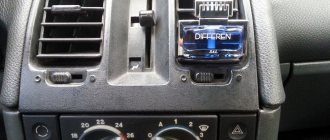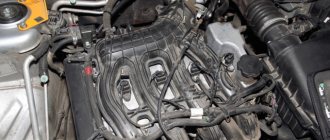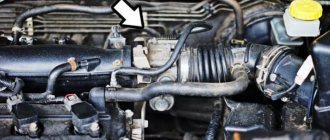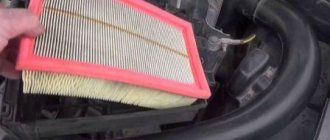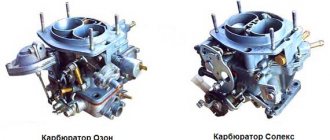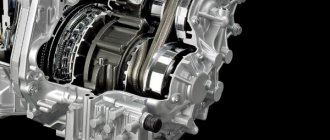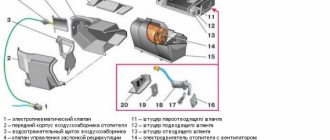For manufacturers of modern cars, one of the important factors is an economical engine, since this significantly affects the cost of owning a car. Reduced fuel consumption leads to insufficient heating of the engine at low ambient temperatures, which negatively affects the heating of the cabin, because the heater takes heat from the engine and distributes it throughout the cabin. But no matter how economical the engine is, it must warm up the interior. Much depends on the method of warming up the engine. You can warm it up while idling, or you can use it while the vehicle is moving. The second method is more effective, since over equal periods of time the degree of heating is higher, and a short distance is covered. But in order to use it, a number of conditions must be met.
You cannot drive fast with a cold engine and transmission. Therefore, if after parking you need to go onto a busy road, this method will not suit you. But if you have a couple of kilometers of road at your disposal, on which you can drive at low speed and not disturb anyone, use this segment to warm up the engine and transmission of the car. This method will save both fuel and time. But if the engine warms up and still blows cold air from the deflectors, then the fault must be looked for in the heater itself.
Replacing or repairing the Nissan Qashqai heater motor: Instructions
A small but quite cozy crossover from Nissan has gained considerable popularity in Russia, and this is justified. Compact in appearance, the car has considerable spaciousness, allowing you to fit comfortably into the cabin. An additional advantage can be considered low fuel consumption - in this Qashqai can be compared to a hatchback.
The first generation Nissan Qashqai J10 has been produced since 2006. In 2010, a restyling was carried out, after which the interior was significantly changed, several new engine and gearbox options were added.
Low fuel consumption is beneficial and pleasant, if you do not take into account the impact of such savings on interior heating. In the 2008 Nissan Qashqai, coolant takes heat from the engine and uses it to heat the air, which is sent inside the car. But if the engine operates with a certain fuel starvation, then its operating temperature is low, and therefore it is not able to fully warm up the car.
Owners of the first generation Nissan Qashqai faced exactly this problem. In addition to the fact that customer reviews indicate frequent breakdowns of the heater motor, even without any defects it barely warmed up the interior.
After restyling, the situation changed for the better. Even though the parts of the heating system have not become better or more durable, the interior of the Qashqai has become warmer and more comfortable.
The second generation of the 2014 Nissan Qashqai J11 (restyling in 2017) came out with major changes and no longer has such problems. The heating system has been redesigned, so now the owners of this car do not have to freeze. By warming up a new car (no older than 2012) for 10-15 minutes, you can create quite comfortable conditions in the cabin, even if there is a specific minus outside.
Replacing the stove motor
The Achilles heel of the first generation Nissan Qashqai is the heater motor. The main problems that arise with it:
- Brushes and lamellas quickly wear out, and the winding burns. In this case, the stove stops “blowing”. If this is the problem, you can try to repair the motor.
- Failure of the transistors leads to the fact that the speed of the motor is not regulated. In this case, the transistors have to be changed.
- An extraneous hum or creaking noise during operation of the stove warns of an imminent replacement of the motor. The bushing wears out quite quickly, which causes suspicious sounds. Many people try to replace it with a bearing, but this is not the best idea: it will take a lot of time, and the result will still not be quiet operation.
Low flow rate or rapid loss of coolant may be associated not with the stove itself, but with the radiator or pipes. Before disassembling the stove, it is necessary to check the integrity of these elements. It may be necessary not to repair the electric motor, but to replace the heater radiator or broken hoses.
A clogged cabin filter may also be the culprit for poor heating of the cabin; before buying new parts for the stove, it is recommended to first replace the filter. Perhaps this will completely solve the problem.
Replacing a Nissan Qashqai heater motor is not the easiest procedure, so most Qashqai owners prefer to go to a service station, despite how much quality costs. The average cost of work will be 2000 rubles, to which the cost of the motor is added - 4000-6000 rubles. If you need to replace the transistor, you can buy a new one for 100-200 rubles.
If new spare parts are available, replacing the stove motor by professionals will take 3-4 hours. self-repair with skillful hands with all the necessary tools - twice as much. If you have never had to do this kind of work before, but you have a tool, a broken stove and a desire to fix it, you will have to spend at least two days on the problem. But next time it will definitely be faster and easier.
A motor for a stove is a spare part that is better to buy new rather than used, and you won’t have to look for it for a long time. The fact is that the motors on the Nissan Qashqai and X-Trail are absolutely identical.
Numbers of the original heater motor for Nissan Qashqai:
- 27225-ET00A;
- 272250ET10A;
- 27225-ET10B;
- 27225-JD00A;
- 27225-ET00B.
Numbers of the original heater motor for Nissan X-Trail:
- 27225-EN000;
- 27225-EN00B.
You can safely buy a motor with any of these numbers; it will be suitable for replacement.
How to change a stove motor with your own hands
Before you replace or repair the motor, you need to make sure that the problem is not a blown fuse.
List of tools required to replace a heater motor with your own hands:
- ratchet with extension;
- a T20 Torx screwdriver for it;
- heads for 10 and 13 or wrenches of the same size (but more convenient than heads);
- pliers;
- flat and Phillips screwdrivers;
- clip removers
Step-by-step work process:
- The car is de-energized (first the negative terminal is removed, then the positive terminal).
- The cable for opening the hood is disconnected.
- The following are removed sequentially: the left side part of the dashboard and the lower part of the panel under the steering wheel - all with rivets, the location of which is best determined in advance.
- The climate sensors and the connector from the left button block are disconnected.
- We find the upper chamber of the intake damper and remove the clamp from it that secures the wiring.
- The pedal assembly is removed (before this, the connector is removed from the brake and gas pedal ends).
- After this, the cabin filter housing snaps off.
- The power connector is disconnected from the motor, which is turned counterclockwise and removed.
After the motor is removed, it must be cleaned of debris and dirt and the winding and brushes inspected. If it is impossible to restore the functionality of the old heater motor, the new one is installed in the same place in the reverse order.
The heater fan is replaced after the electric motor is disconnected, removed and cleaned.
Replacing the heater fan
Constant fan speed, unusual squeaks and lack of air flow after turning on the heating may indicate problems with the fan. This does not necessarily mean that the furnace fan will need to be replaced unless the physical integrity is compromised.
The heater motor for Nissan Qashqai is sold complete with impeller and housing. In a Nissan Qashqai, replacing the heater fan is possible, but not rational - if the impeller is damaged or even slightly bent, the heater will make a strong noise and will fail quite quickly, and it is almost impossible to carry out balancing on your own.
Common Causes
Poor operation of the stove can be caused by the following:
- Drop in coolant level. Too small a volume of antifreeze in the tank often leads to the formation of air pockets; a certain segment of the radiator does not warm up, so cold air comes out of the stove.
- Thermostat failure. The surface of an unheated engine before the thermostat should be hotter than after it. If this phenomenon is not observed, then the thermostat is faulty.
- Cabin filter clogged. To check, a simple visual inspection is carried out; if the filter is dirty, it is changed or cleaned.
- An air lock inside the radiator, corrosive deposits that prevent the normal circulation of antifreeze - all this can be checked by touch by assessing the temperature of the pipe at the inlet and outlet of the stove. A significant difference in temperature indicates a problem.
- The fan is broken, which prevents the formation of a sufficiently intense air flow. Problems with the fan may include its motor, which is burned out or not receiving power due to wiring problems, and the impeller, which has received mechanical damage.
- Pump failure, which disrupts the circulation of antifreeze. Insufficient heating in such a situation is still half the problem; the danger of overheating the motor itself is much worse.
- Heater resistor failure
- The resistor block (Module Assy-Pow 27226-70T03) responsible for controlling the climate control motor has burned out.
- Problems with the heater damper and incorrect operation of the motors, as a result of which the marks on the gears are lost (In total, we have two heater damper motors on the right and left). Statistics show that this reason is the most common, and therefore we will focus on it.
How to fix the heater in a Nissan Qashqai car
› Air system ›
16.10.2017
For manufacturers of modern cars, one of the important factors is an economical engine, since this significantly affects the cost of owning a car.
Reduced fuel consumption leads to insufficient heating of the engine at low ambient temperatures, which negatively affects the heating of the cabin, because the heater takes heat from the engine and distributes it throughout the cabin. But no matter how economical the engine is, it must warm up the interior. Much depends on the method of warming up the engine.
You can warm it up while idling, or you can use it while the vehicle is moving. The second method is more effective, since over equal periods of time the degree of heating is higher, and a short distance is covered. But in order to use it, a number of conditions must be met.
You cannot drive fast with a cold engine and transmission. Therefore, if after parking you need to go onto a busy road, this method will not suit you. But if you have a couple of kilometers of road at your disposal, on which you can drive at low speed and not disturb anyone, use this segment to warm up the engine and transmission of the car. This method will save both fuel and time. But if the engine warms up and still blows cold air from the deflectors, then the fault must be looked for in the heater itself.
Diagnostics
In Nissan Qashqai, as in other cars with a liquid-cooled engine, the heater uses engine heat for heating. Therefore, the point of diagnostics is to understand at what section of the heating system (which is associated with engine cooling) the operation becomes incorrect.
- Check the coolant level. When the tank is filled below the minimum level, there is a high probability of an air lock forming in the heater core, which is why part of the radiator will be constantly cold and the air passing through it will not warm up sufficiently.
- Make sure the thermostat is working correctly. This can be done either using a pyrometer or by touch. The degree of heating of the surface (unheated engine) before the thermostat should be significantly higher than after it. These values should equalize after 80° C. If the temperature readings are the same throughout the entire operation of the motor, it means that the thermostat is not working correctly and must be replaced.
- Check the capacity of the cabin filter. Due to the fact that “outboard” air is used to heat the interior, which contains a large amount of impurities (dust, dirt, etc.), it needs to be cleaned. For cleaning, a filter element is used, which is capable of passing only air through itself, and all impurities remain on the ribbed structure. Like the engine air filter, it needs to be replaced when performance deteriorates.
- Make sure there is good flow of coolant and air through the heater core. From the outside, the radiator can become clogged with dust and prevent the free flow of flow through the honeycombs. A rust plug may form in the internal part, which will block the free passage of liquid through the radiator, which will negatively affect the heat transfer of the interior heating system. To check for blockage, you need to touch the temperature of the pipes at the entrance to the stove and at the exit from it. They should be approximately the same. If the inlet pipe is warm and the outlet pipe is cool, then the plug is inside the radiator. In this case, it is necessary to clean or replace it, since for good heating of the interior, unhindered circulation of liquid through all elements is necessary.
- A broken heater fan can cause poor heating, since the interior is heated by forcing cold air through a hot radiator. The fan is responsible for “pumping” air. It may not work at all or work incorrectly. If there are no signs of “life” in the electric motor, it is necessary to check the serviceability of the fuse. If it burns out, it is necessary to eliminate the short circuit (it can be in the wiring or in the electric motor). The impeller may also be faulty. It is made of plastic, which itself is a very fragile material, and over time can be destroyed by rotation. When the impeller is destroyed, air circulation deteriorates and heating becomes insufficient.
- A poorly functioning or jammed pump significantly impairs the circulation of fluid through the system, which, in turn, leads to unsatisfactory heating. This breakdown threatens the failure of the entire motor, since heat is not removed from highly heated parts, causing them to overheat. This type of breakdown can only be diagnosed in the early stages. For diagnosis you need:
- switch the heater control to manual mode and set the maximum temperature;
- turn on the fan at medium speed and place your palm near any deflector;
- When increasing engine speed, monitor the increase in flow temperature; if the increase is significant, then the pump is faulty.
Debugg
Many people are interested in the question: “When the stove in a Nissan Qashqai does not heat well, how to fix the breakdown.”
When the heater blows cold air in a Nissan Qashqai, you need to act like this:
- If there is little coolant in the coolant tank, you need to check the system for leakage and fix it. Next, coolant should be added to the volume recommended by the manufacturer. The next step is to remove the air lock by pushing the pipes while the engine is active.
- When the thermostat is faulty, the coolant is drained and the element is replaced with a new one. The procedure is simple and does not require special skills. After replacing the element, coolant is poured into the system according to the scheme outlined above.
- Sometimes the stove in Qashqai does not heat due to a clogged air filter. The phenomenon is characterized by fogging of the glass when the stove is operating, as well as the release of an unpleasant odor when the fan is activated. To fix the breakdown, dismantle the glove compartment, open the lid and remove the worn filter. Before installing a new filter, remove contaminants.
- When cold air blows into your Nissan Qashqai, you should clean the radiator. The honeycombs are cleaned of dust, and the inside is freed from rust and other accumulations. Next, it is recommended to clean the system using forced circulation of water or a special reagent until it is completely clear of debris.
- Sometimes the Nissan Qashqai's heater does not heat well due to problems with the electric motor. There may be no power or a blown fuse. When there is no problem with the power supply, but the engine is still acting up, you should try to revive it or immediately replace it with a new one.
- It is important not to start driving a car with a broken or inactive pump. If the pump does not work correctly, the defect is first eliminated, then trips are made. When heat is not removed from overheated elements, they become deformed, which will cause expensive repairs of the internal combustion engine. The pump consists of an impeller and a pulley. The belt drive allows the pulley to rotate the impeller, which circulates the coolant. The impeller operates in an aggressive environment, which over time leads to its destruction, as a result of which the coolant movement pressure will drop and the heating system will begin to work ineffectively.
Damper adjustment
Adjusting the Nissan Qashqai heater flaps is also a fairly simple procedure and can be done on your own:
- The bolt securing the rod to the drive is slightly loosened.
- The damper lever is installed in a position where it is completely open.
Damper position at maximum set temperature
Damper position at minimum set temperature
- The rod is pulled out of the casing, the mounting bolt is tightened.
- The damper drive handle is pulled out to the maximum, which can be determined by the fact that the damper itself has completely closed.
- If the damper does not close, the rod shell bolt is unscrewed.
- When moving the shell you need to look at the damper. If it is closed, the mounting bolt can be fully tightened. This completes the adjustment.
Selection and prices
There are plenty of options to choose from. In different stores the prices for the motor will be different and on average its cost is 3000 - 4000 rubles.
You can buy it at car wrecking yards for half the price.
The motor is sold with the housing and impeller assembly. The Nissan Qashqai (J10) and X-Trail (T31) models have the same ones.
The original Qashqai heater motor has not one number, but five:
27225-ET00A, 27225-ET10A, 27225-ET10B, 27225-JD00A, 27225-ET00B
Original heater motor XTrail two numbers:
27225-EN000, 27225-EN00B
Moreover, all seven numbers are the same spare part!
If we have to make do with replacing the transistor, we purchase a new one for independent repairs or at the request of the technician. The following options are suitable:
IRFP064N
— 55V, 98A — recommended for purchase.
IRFP064NPFB
- 55V, 98A - this is a modification, recommended for purchase.
IRFP044
- 60V, 57A.
IRFP054
- 60V, 70A - can be taken.
IRFP048
- 60V, 70A - can be taken.
IRFP250N
- 200V, 30A - this one burned out in a day, the current is not enough.
The average price of a transistor is from 95 rubles. up to 200 rub.
Heater fan motor replacement services and cost.
This procedure is quite labor-intensive and requires certain skills. Therefore, it is better to trust those people who have experience in such things. At service stations, the work will cost about 2,000 rubles, without the cost of a new engine.
If you wish, you can make the replacement yourself, but it will take much longer than it will take in the service department.
